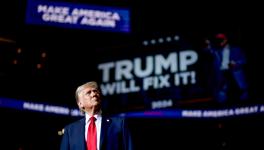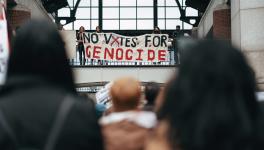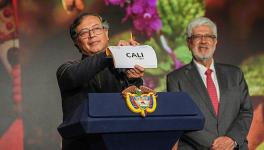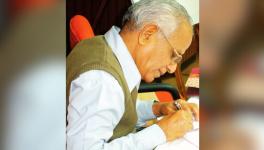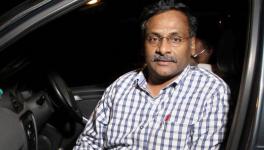50 Years After Chile’s Coup, the First Year of Popular Unity
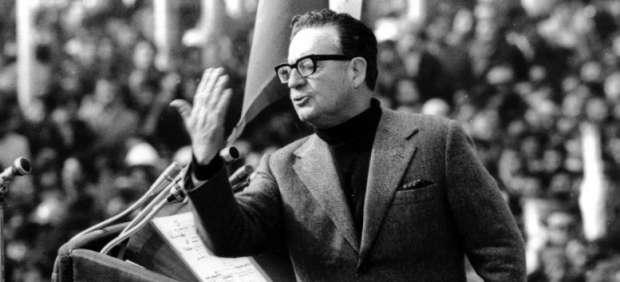
Salvador Allende. Image Courtesy: Wikimedia Commons
Ten days after the 1973 coup against the Popular Unity (UP) government of President Salvador Allende, the military opened the Río Chico concentration camp on Dawson Island, located in the Strait of Magellan, near the southern tip of Chile. The island had served as an extermination camp by a Catholic order between 1891 and 1911 to confine the Selk’nam and Kawésqar peoples, who died due to overcrowding, the spread of disease, and the cold.
The coup regime sent 38 officials of the UP government to the Compañía de Ingenieros del Cuerpo de Infantería Marina (COMPINGIM) naval base and then to the Río Chico camp. It also sent hundreds of political prisoners to Punta Arenas, near Dawson Island. The officials were interrogated, tortured, and forced to work on the island’s infrastructure. The Río Chico camp was dismantled in 1974.
One of the prisoners at the camp was Miguel Lawner, an architect who led the government’s Urban Improvement Corporation (CORMU). During his imprisonment, Lawner walked around the prison to calculate the size of his room, the buildings at the camp, and the camp itself. He drew the layout for the camp but then destroyed it for fear of discovery by the guards. When he was in exile in Denmark in 1976, Lawner redrew the plans from memory. “The function creates the organ,” he said. “I developed an organ: the drawing, capable of fulfilling the function of leaving testimony of our captivity.”
During his imprisonment, Lawner told me, he worried that the military might accuse him of corruption for his leadership of CORMU. “I was trying to calculate how many millions of dollars had been [spent] in my name,” he recalled. “I calculated it to be between $150 million and $180 million. Later, I learned that the military spent six months investigating me and came to the conclusion that they owed me a per diem!”
The UP government (1970-1973) felt that the ministries of Housing and Public Works should be the engine of the economy, as “the two easiest institutions to mobilize,” Lawner said. Other areas, such as industrialization, “required more prolonged prior studies.” “In housing,” Lawner told me, “if you have a vacant lot, the next day you can be building.” In addition, there was a huge need for housing. The CORMU management decided to speed up the bureaucratic procedures and authorize the immediate disbursement of funds through an official, who was Lawner. “Our first year of government was a year of marvelous irresponsibility,” Lawner told me with a smile on his face.
Never Deviate From the Fundamentals
During the 1970 campaign for the presidency, Lawner accompanied Allende to a camp on the banks of the Mapocho River, where the people lived “outside the walls of society.” As they left the camp, Allende said to Lawner, “Even if things go badly for us, to get these comrades out of the mud—for that, it would be worthwhile for them to elect me president.” One year into the government, Lawner said, “We delivered the first houses of Villa San Luis. In April ’72 we had this project completely delivered: a thousand houses, the great majority of which corresponded to these two camps, el encanto and el ejemplo, which sat on the banks of the Mapocho River.” The main task of the UP government, he said, was “to resolve the fundamental demands of the sectors that had always been dispossessed.”
Under Lawner’s leadership, the CORMU officials—not all of them part of the UP project—postponed vacations and worked without overtime pay. “We gave all these officials the conviction that they were operating for the benefit of the common good and not, obviously, for the enrichment of a private company or the banks. In other words, they knew that they were working so that people could live better.” Also, he said, the objective of “making things beautiful” was imposed, arguing “that in social housing, beauty does not have to be the birthright only of the rich.”
The Explosion of the Countryside
Lawner recalled his great pride at the UP government’s nationalization of copper, its delivery of houses, and its role in the “explosion of the agrarian world.” The agrarian reform and the law for peasant unionization were passed in 1962, before the UP government. However, agrarian workers “continued to exist like serfs from feudal times,” Lawner noted. A week into his presidency, Allende was invited by the peasants of Araucanía to a meeting to which he brought his minister of agriculture, Jacques Chonchol. When an Indigenous leader spoke, Allende leaned over to Chonchol and said, “Listen, minister, I think you should remain here.” The minister, who “had to send for even his toothbrush,” remained there for three months, beginning his term installed in the countryside. Half a million hectares were transferred to the landless in the first year of the government.
The UP’s first year, Lawner recalled, was a “year of unbridled aspirations.” “For a person like me who was never a public official, the feeling of power is infinite, and the conviction that you are capable of doing anything is equally infinite… we promised more than we were capable of doing [having done three or four times more than the most that had ever been done in the history of the housing ministry], but everything we could do was done because of what is now lacking: the commitment of the officials. You have to have good leadership, it is true, but if you don’t have the commitment of the base, there is nothing you can do.”
Generations Contaminated by the Model
When we talked about the differences between the experiences at the end of the first year of the UP and the first year of Chile’s current President Gabriel Boric’s progressive government, Lawner pointed out that, in Chile “we have effectively been fed for 50 years the neoliberal doctrine of a formation contradictory to what you require in a progressive government. Imperceptibly, generations were formed that are, in my opinion, corrupted by the model. It is incomprehensible to them any other way.”
The current president of Chile’s Senate is Juan Antonio Coloma, a man of the extreme right. “When the 50th anniversary of the coup comes this September,” Lawner told me, “Coloma will be the country’s second most important political official.” Fascism’s rise, he said, is a global phenomenon, not only taking place in Chile. But Lawner does not despair. “You cannot determine when there is a spark that lights the fire again, but there is no doubt that it is going to happen.”
Taroa Zúñiga Silva is a writing fellow and the Spanish media coordinator for Globetrotter. She is the co-editor with Giordana García Sojo of Venezuela, Vórtice de la Guerra del Siglo XXI (2020). She is a member of the coordinating committee of Argos: International Observatory on Migration and Human Rights and is a member of the Mecha Cooperativa, a project of the Ejército Comunicacional de Liberación.
Source: This article was produced by Globetrotter.
Get the latest reports & analysis with people's perspective on Protests, movements & deep analytical videos, discussions of the current affairs in your Telegram app. Subscribe to NewsClick's Telegram channel & get Real-Time updates on stories, as they get published on our website.












